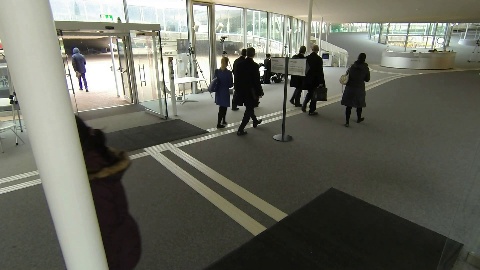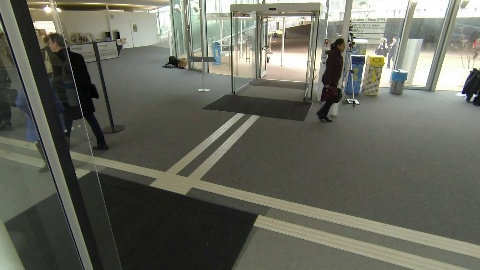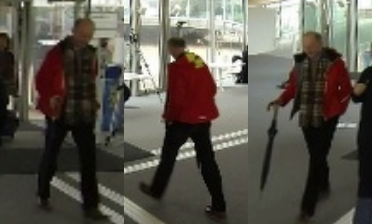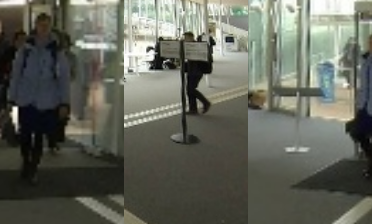The EPFL-RLC dataset was recorded in the EPFL Rolex Learning Center using three static HD cameras. Unlike most of the existing multi-camera datasets, the cameras’ fields of view are overlapping. Each camera has a resolution of 1920×1080 pixels and during the acquisition a frame rate of 60 frames per second was used.
 |
 |
 |
| Camera 1 | Camera 2 | Camera 3 |
The video sequences which are available for download are synchronized across the views and each sequences contains 8K frames of post-processed frames of resolution 480×270.
The cameras are calibrated using the Tsai calibration [Tsai86]. The calibration files are included in the dataset.
Positions file
The ground of the intersecting area is discretized as regular grid of points. The 3D space occupied if a person is standing at a particular position is modelled by a cylinder positioned centrally on the grid point. Each cylinder into the 2D views projects as a rectangle.
Using a 55×45 grid and the provided calibration files of the cameras, we generate a file containing each position’s projections into the three views. Each position is assigned an ID.
Annotations
The annotations represent a set of multi-view examples extracted from the first frames. Note that the frames are not fully annotated, but rather multi-view examples of detections visible in all of the views are annotated. It consists of 4088 multi-view balanced manually annotated examples of two classes: occupied position – positive detection, and free position – a negative detection. Each multi-view annotation also contains the ID of the position it originates from, according to the positions file explained above.
 |
 |
| Positive multi-view example | Negative multi-view example |
Since a negative multi-view example does not necessarily imply that in each of its views there is no pedestrian, each negative multi-view example contains additional annotated information whether it contains a person. This information can be exploited if the dataset is used for monocular detection.
Download
References
| [Tsai86] | R.Y. Tsai, An Efficient and Accurate Camera Calibration Technique for 3D Machine Vision, Proceedings of IEEE Conference on Computer Vision and Pattern Recognition, Miami Beach, FL, pp. 364-374, 1986. |
Publication
Please note that the publication lists from Infoscience integrated into the EPFL website, lab or people pages are frozen following the launch of the new version of platform. The owners of these pages are invited to recreate their publication list from Infoscience. For any assistance, please consult the Infoscience help or contact support.